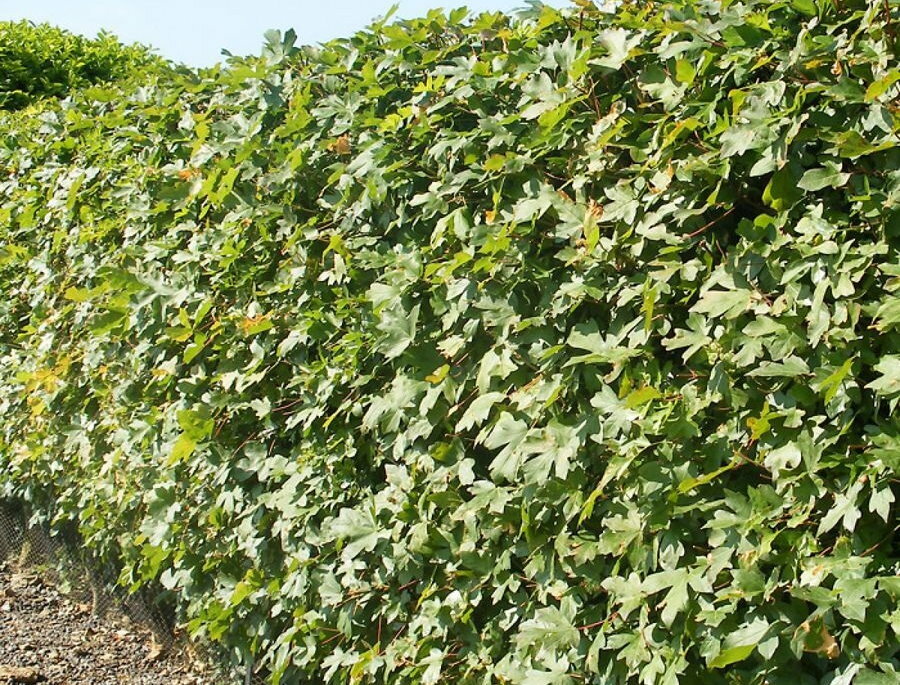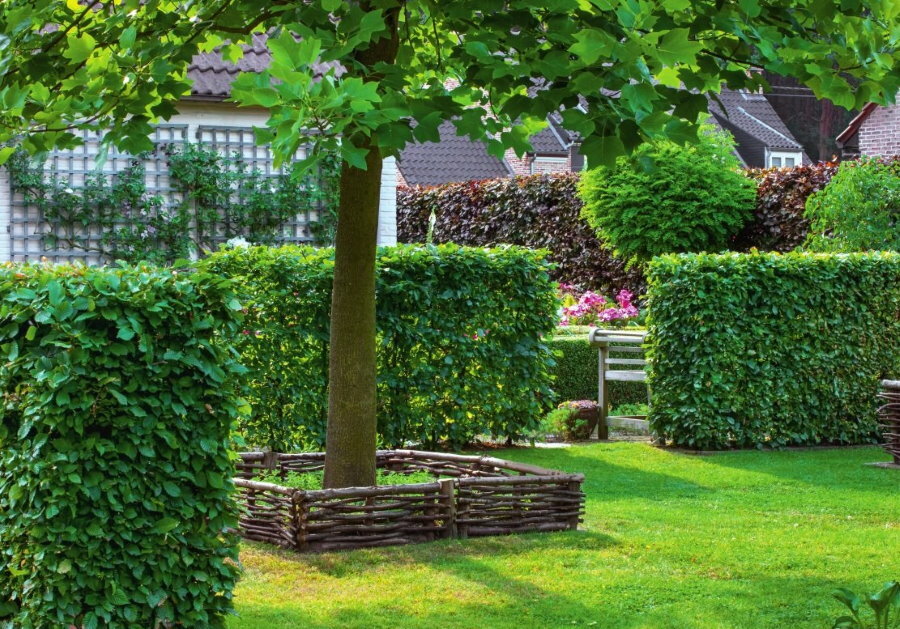A hedge is a chic alternative to perimeter or multiple-sided garden fencing. Such plantings are used for zoning the territory, border framing of terraces, courtyards, garden paths. Blending organically into the surrounding space, green spaces complement the landscape and make it more beautiful.

There are countless hedge options
Hedge in landscape design - advantages and disadvantages
Content
- Hedge in landscape design - advantages and disadvantages
- Varieties of plant fences
- Single-row and multi-row options
- Decorative living borders
- Medium and high fences
- Which plants are suitable for hedges?
- Evergreens for hedges
- Curly fences
- Deciduous fences
- Coniferous fences
- Hedge trimming shape
- Hedge formation
- Original haircut ideas (photo examples)
- Video: Choosing plants for a hedge
- Photo: 50 options for hedges in the garden
Single-row and multi-row planting of trees, shrubs perform several functions at once:
- They hide unsightly buildings, vegetable plantings from the eyes.
- They create a closed space for relaxation, games, protected from the wind.
- Serve as a barrier for domestic and wild animals.
- Provide protection from street dirt, dust, reduce noise.
The main disadvantage of such fences is that hedges in landscape design require maintenance, like other green spaces.

The painstaking work of pruning shrubs takes a lot of time
Blooming curbs are a bright decorative element of the facade or path design, a good solution that combines functionality and beauty. Living walls around the perimeter are a reliable shield, giving a blessed shadow to the mot.

Blooming hawthorn hedge, which successfully sets off the green massif
Fences must meet architectural and aesthetic requirements. When choosing crops, it is worth considering the intensity of growth, pruning flexibility, and cultivation features.
When buying planting material, it is important to know what kind of crown is formed in a tree and a shrub, what kind of neighborhood with a seedling is acceptable so that the plants do not oppress each other.
Varieties of plant fences
Plants planted in strips can be free-growing, take up a lot of space, and shape, neatly trimmed to a specific shape. You can plant bushes and trees in one or more rows. The classification of green fences is based on the natural crown shape and biological characteristics.

The hedge looks original, diluted with decorative inserts
Curbs reach one meter in height, fences - up to 2 m. Fences over two meters are called living walls.

Behind the living walls, you can hide a cozy place to relax
For planting, it is better to choose zoned varieties that are distinguished by good survival rate, disease resistance, and the influence of weather factors.
Single-row and multi-row options
It is customary to plant flowering shrubs in one row, forming a dense crown. If plants are planted at a certain distance from each other, as they grow, a green barrier or dense border will form. For functional zoning within the site, hornbeam, turn is suitable. Berries look good: currants, irga, cherry, honeysuckle. From the side of the road, the area is well protected by lilacs, which absorb heavy metals, and thorny rose hips that impede the passage.

Hornbeam grows well in any soil and is suitable for creating hedges from 1 to 4 meters in height
For multi-row planting, crops are chosen that can coexist; in the description of the variety, it is necessary to clarify the basic growing conditions, the need for lighting, water, nutrients. An important factor is soil acidity.

Multi-tiered hedge: at the very bottom there is a garden strawberry, above the spirea, and photinia completes the composition
Some cultures exist in organic symbiosis. For example, coniferous litter increases the acidity of the soil. Hydrangeas get along well with junipers.
Double or three-line compositions are made multilevel, using color combinations: red-leaved beech or barberry will emphasize the beauty of geraniums, roses, peonies, lilies look spectacular against the background of dark greenery of evergreens and conifers rocks.

Red-leaved beech effectively adorned the garden arch

Forest beech harmoniously covers the corner of the suburban area
Decorative living borders
For curbs, choose low-growing and medium-sized plants. These can be flowering perennials and bushes with decorative foliage. A good solution would be to use undersized annual and perennial flowers. The upper tier of shrubs will be able to supplement the border: heather, chubushnik, tree varieties of hydrangeas, Vangutta spirea and others.

For low borders framing any garden compositions, you can choose small-leaved boxwood
Medium and high fences
For medium plantings, hawthorn, cotoneaster, red-leaved and white-leaved maples, undersized pine, Canadian spruce are used. Alpine currant looks decorative.

A chic hedge emerges from the field maple, which grows equally well both in the shade and in the sun
With a multi-row planting behind a juniper hedge, you can plant rowan, beauties of linden, enveloping in a delicate aroma during the flowering period.
When forming green fences, it is necessary to provide for passes for tillage, cutting shrubs.

Those who wish to decorate the garden with a bright composition can pick up shrubs with different colors of leaves
Which plants are suitable for hedges?
The choice depends on the taste preferences of the site owners and climatic conditions. Heat-loving crops do not tolerate severe winters, even under shelters they can freeze out. Preference is given to shrub varieties:
- with decorative foliage;
- changing color with the onset of autumn;
- having beautiful fruits.

In the photo there are beautiful borders from a brilliant cotoneaster, the decorativeness of which is most effectively manifested in the autumn period
Ornamental plants that can be formed are planted along the outer borders so that the plantings do not interfere with neighbors, do not spoil the street landscape.
It is worth paying attention to the wild plants growing nearby. They can decorate a summer cottage no worse than purchased crops.
Evergreens for hedges
Plants that do not shed their foliage in winter decorate the landscape all year round. The following are considered popular:
- ligustrum or privet, the bush tolerates a haircut well;
- boxwood;
- variegated or monochromatic euonymus;
- holly;
- evergreen barberry;
- bladder with white fruit peas.
These shrubs are unpretentious to care for, grow quickly.

Thorny branches of barberry will not allow animals or people to enter the garden
Curly fences
Climbing varieties are planted near mesh fences, used to mask unsightly buildings, make trellis options for hedges.

Climbing plants can be twisted around an ordinary fence at the border of the site (pictured here is a living ivy fence)
To create a green wall, choose:
- Japanese ivy, which grows well in Europe;
- unpretentious hops, forming picturesque bumps;
- picturesque clematis;
- colorful periwinkle.
Among the hydrangeas, long shoots are formed by the petiole variety used for trellis decoration.

Gorgeous living wall of petiolate hydrangea
Deciduous fences
Trees and shrubs are used for planting. Among the profusely blooming spirea hedges can be distinguished; there are white, yellow, cream options with spherical and creeping crowns. The fast-growing turf, which reaches 3 meters in height.
Hornbeam, beech, willow are used more often. Extraordinarily decorative elderberry, viburnum, panicle hydrangea.

In the photo, a hornbeam hedge dividing the garden into functional zones
Coniferous fences
Cypress, thuja grow well in warm regions. In the Urals, in Siberia, hedges and ordinary spruce are formed, a dense row is created from seedlings. Spruces are distinguished by good frost resistance, decorativeness, and form a dense hedge.

A first-class hedge emerges from the thuja - dense, does not take up much space and does not require frequent haircuts
The advantage of conifers is that they do not need to be shaped. Crowns grow neat, if they do not interfere with nearby buildings or mesh fences.
Pyramidal juniper often deforms under snow load, so in snowy regions it is advisable to equip special barriers from branches.
Landscape designers prefer green fences made of bluish fir trees or decorative balsamic fir with soft needles. When transplanting wild-growing spruce forests, it is important to observe the position of the cardinal points, then the plant will quickly acclimatize.

Decorativeness all year round - a huge advantage of coniferous hedges
Hedge trimming shape
Depending on the natural shape of the crown, walls are created with a section in the form of a trapezoid, triangle, circle. The hedge, which gives a large increase, is cut several times per season.

Unique shapes can be created by leaving a couple of branches during the next pruning, and later forming mini-crowns from them.
Rows of identical figures look beautiful. The trapezoidal shape is optimal for yew, hornbeam, boxwood. The lower branches receive enough light for growth, the crown grows dense.
Globular bushes are created from cherry laurel, privet, barberry, spirea, which are easy to cut. For a perfect look, corrective pruning is done up to 5 times a year.

Spirea spirea looks great as a single composition
Triangular and conical shapes are often created on potted plants. A cord is fixed to the top, a peg is driven into the ground. On the bushes growing on the ground, you have to move the lace, the potted ones move along the axis.

Thuja western, formed in the form of a pyramid
During the shaping haircut, no more than 20% of the crown volume is removed so that the plant does not get sick.
Hedge formation
In a shrub, in the second year of growth, shoots are cut off by 1/3. Pruning is carried out throughout the season. To decorate the landscape, ready-made hedges are often purchased, which it is enough to transplant to a permanent place and maintain a given shape in the plants. Care for a live fence needs constant. On average, shoots grow 20 cm per season, fast-growing branches form up to 80 cm.

A group of shrubs cut to fit geometric shapes looks interesting (in the photo from left to right: cypress, thuja, pear)
Original haircut ideas (photo examples)
The ideal option for curly framing is a privet hedge in the form of a wave. The plant gives good growth, you can create any shape.

An undulating privet hedge will add dynamism to the garden

Combination of wooden modules and columnar thuja
An unusual option is columnar thuja in the form of a cylinder or polyhedra. Rows of cones and balls look good. Craftsmen create arched hedges with narrow passages and "Chinese" walls with loopholes. It all depends on the flight of imagination and the possibilities of green spaces.



